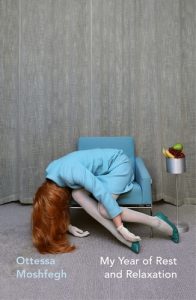
What I learned from ‘My Year of Rest and Relaxation’ by Ottessa Moshfegh
 About the book
About the book
The novel follows the life of the unnamed narrator, a young and wealthy woman living in New York City in the early 2000s. Seeking an escape from the emotional turmoil and societal pressures of her existence, she decides to embark on a radical experiment.
The narrator decides to spend an entire year in a self-imposed hibernation, aided by a cocktail of prescription drugs provided by an unscrupulous psychiatrist. She hopes that by sleeping through the year, she can effectively erase her troubled past and awaken as a new person. During this year of drug-induced sleep, she withdraws from society, disconnecting from friends and family, and avoiding any real engagement with the world.
What I learned
Ottessa Moshfegh seems to have cornered the market in unlikeable characters in recent years. I’ve not read her earlier novel Eileen – with eponymous narrator commonly described as ‘repulsive’ – but decided to dive in with My Year of Rest and Relaxation. It didn’t disappoint.
Moshfegh’s unnamed narrator is a privileged young woman who wants to withdraw from the world with the help a host of tranquilisers (‘Neuroproxin, Maxiphenphen, Valdignore, Silencior, Seconol, Nembutal, Valium, Librium, Placydil, Noctec, Miltown’). She longs to escape the grief she feels over the death of her parents and a failed relationship and seclude herself in her high-end New York apartment until an unnamed point when she believes she’ll emerge, phoenix-like.
She sets about her goal with the help of quack psychiatrist Dr Tuttle, who is only too happy to prescribe her anything she wants, for the most ridiculous of reasons. The only other character the narrator interacts with on a meaningful level is a sort-of friend Reva, who gives her a sense of the outside world, which only fatigues her and makes her want to withdraw further.
What follows is the descent of the narrator into drug-fuelled psychosis. There is no grand plot-twist and not much in the way of third act redemption. Instead, this is a pitch-black book peopled with unlikeable characters. But the sharpness of the humour transforms it into a laugh-out-loud read. The dialogue stood out more than anything – particularly in the exchanges between the narrator and Dr Tuttle:
“How are you feeling?”
I stood and pondered the question for five minutes while Dr. Tuttle went around her office turning on an arsenal of fans, all the same make and model, two installed on the radiator under the windows, one on her desk, and two in the corners of the room on the floor. She was impressively nimble. She no longer wore the neck brace.
“I’m fine, I think,” I yelled blandly over the roaring hum.
“You look pale,” Dr. Tuttle remarked.
“I’ve been keeping out of the sun,” I told her.
“Good thing. Sun exposure promotes cellular collapse, but nobody wants to talk about that.”
There’s withering contempt for the world oozing from every page, and I found it hilarious. I’ve found that humour in a lot of contemporary fiction seems afraid to go too dark, so it was refreshing to read something that finds humour in the bleakest of places.
More about this book
Published in 2021 by Vintage Classics
My Year of Rest and Relaxation at Vintage Classics
About ‘What I learned…’
 About the book
About the book